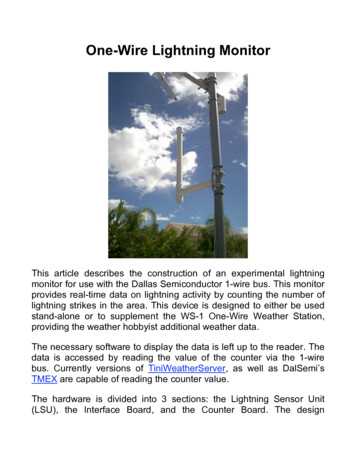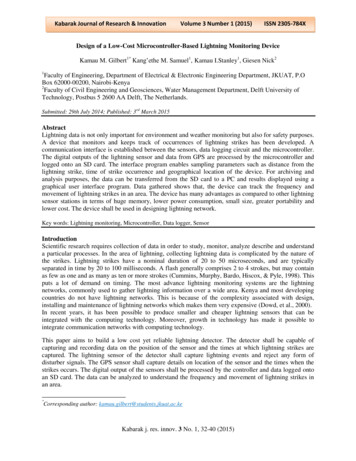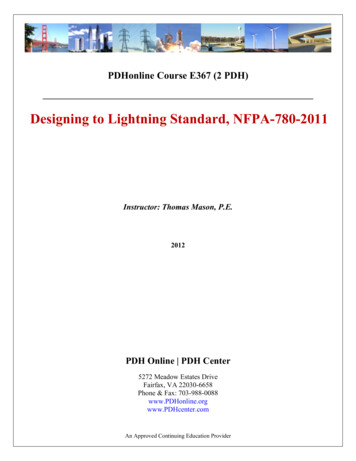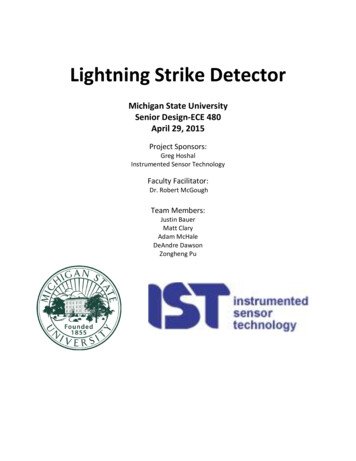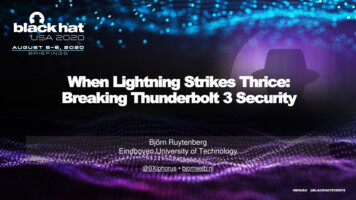
Transcription
When Lightning Strikes Thrice:Breaking Thunderbolt 3 SecurityBjörn RuytenbergEindhoven University of Technology@0Xiphorus bjornweb.nl#BHUSA@BLACKHATEVENTS
Who Am IBjörn Ruytenberg@0XiphorusVulnerability researcherMain interests: hardware and firmware security, sandboxing, input validationMore about me: https://bjornweb.nlMSc student in Computer Science @ TUE This work part of master’s thesis2
PCI Express Basics – Quick Review A standardized interconnect for attaching hardwaredevices in a computer system Designed as CPU-architecture agnostic, internal I/Ointerconnect for low-latency, high-bandwidth Intended to overcome limitations of PCI, mostnotably: Scalability: per-device configurable bandwidth, flexiblelink width Networking: moves from bus to packet switching;allows for more flexible topology, QoS / congestioncontrol Network topology: root complex, switch, endpoints,PCIe to legacy bridge (e.g. ISA/PCI/PCI-X) Direct Memory Access (DMA) primary CPUperipheral mode of transport3
Thunderbolt: A PCIe-based Interconnect High-performance, proprietary I/O protocol developed by Intel and Apple PCIe-based, Direct Memory Access (DMA)-enabled I/O Use cases External graphics, docking stations, 5K monitors, high-speed external storage, peer-to-peernetworking Thunderbolt 1 (2011) and 2 (2013) mostly exclusive to Macs Mini-DisplayPort form factor – multiplexes TB, native DP Thunderbolt 3 (2015) first version to be widely adopted USB-C form factor – multiplexes TB, native DP and/or USB-C4
DMA attacks Thunderbolt 1: no protection againstphysical attacks Plug in malicious device Unrestricted R/W memory access (DMA) Access data from encrypted drives Persistent access possible, by e.g.installing rootkit5
DMA attacks (selected) Owned by an iPod [Dornseif 2004] First research to demonstrate practical DMA attack Malicious FW device presents Serial Bus Protocol 2 (SPB-2) endpoint, which triggers host controller to allocate DMA channel for fast bulkdata transfers Several authors release exploitation tools [Boileau 2006] [Plegdon 2007] Improved upon for memory forensics [Witherden 2010] “Improved upon” in law enforcement spyware such as FinFireWire [Gamma 2011] Subverting Windows 7 x64 kernel with DMA attacks [Aumaitre 2009] First PCI-based attack through custom PCI device with DMA engine Inception [Maartmann-Moe 2014] Improves upon Witherden’slibforensic1394by presenting virtual SBP-2 interface through ExpressCard, FW device TB-to-FW adapter PCILeech [Frisk 2016] Native PCIe attack DMA attack using FPGA with PCIe PHY (full size, ExpressCard, miniPCIe, M.2-NVMe), optionally tunneled through Thunderbolt enclosure Improved later with various functionality: e.g. dumping FDE keys, dumping UEFI memory regions, patching Windows lock screen process Thunderclap [Markettos et al. 2019] Replaces PCIe endpoint in TB device with malicious one, then performs DMA attack Does not break Security Levels access control, but relies on tricking user into authorizing malicious device6
Threat Model Brief physical access to victim system, aka “evil maid attack” Example real-world scenarios: Laptop locked or set to sleep; left unattended in hotel room, while victim isout for dinner Desktop systems locked or set to sleep; left unattended outside office hours Cleaning crew has unfettered access7
Threat ModelIndustry measures against opportunistic physical access1.2.3.4. BIOS access controlSecure BootBoot GuardFull Disk Encryption8
Threat ModelIndustry measures against opportunistic physical access1. BIOS access control Prevents unauthorized modification of systemsettings E.g. require password on entering BIOS9
Threat ModelIndustry measures against opportunistic physical access1. BIOS access control2. Secure Boot Protects against malicious, unsigned code earlyin boot process Cryptographically verify boot chain:OS bootloader, kernel, drivers10
Threat ModelIndustry measures against opportunistic physical access1. BIOS access control2. Secure Boot3. Boot Guard Protects against malicious firmware implants Cryptographically verifies BIOS integrity11
Threat ModelIndustry measures against opportunistic physical access1.2.3.4.BIOS access controlSecure BootBoot GuardFull Disk Encryption Protects against physical data extraction Encrypts user data OS root (depending on FDE config)12
Threat ModelIndustry measures against opportunistic physical access1.2.3.4.5.BIOS access controlSecure BootBoot GuardFull Disk EncryptionThunderbolt Security Levels13
Thunderbolt Security Architecture Security Levels – access control system enabling users to authorizetrusted device only Introduced in Thunderbolt 2 No authorization No PCIe tunneling14
Thunderbolt Security ArchitectureThunderbolt devices authenticate to the host using the following metadata: Device ID: 16-bit device identifier Device name: ASCII string Vendor ID: 16-bit vendor identifier Vendor name: ASCII string Universally Unique Identifier (UUID): 64-bit number uniquely identifying device, fused insiliconSource: Thunderbolt 3 and Security on Microsoft Windows 10 Operating System – Intel Corporation15
Thunderbolt Security LevelsSL0NoneSL1UserSL2SecureSL3No PCIetunnelingSL4Disable daisychainingPre-bootprotectionDefinition No security (legacy mode) Device authorization ACL based on UUIDUUID fused in siliconDefault setting on all PCsDevice authorization based on UUID (SL1), plusCryptographic device authentication (challenge-response) Disable all Thunderbolt connectivityUSB and/or DisplayPort tunneling onlySecurity Levels prevent malicious TBdevices from accessing PCIe domain,thereby protecting against: Device-to-host DMA attacks Device-to-device (P2P) DMA attacks PCI ID spoofing to target vulnerable devicedrivers TLP source ID spoofingTerminate PCIe tunneling at first TB device(some Titan Ridge controllers only)PCIe tunneling enabled only if Thunderbolt device previouslyauthorized by userSource: Thunderbolt 3 and Security on Microsoft Windows 10 Operating System – Intel Corporation16
Introduction to Thunderspy Previous research: Before Security Levels: attacks primarily focus on PCIe-level DMA attacks to compromiseThunderbolt security After Security Levels: attacks require cooperation of user, i.e. inadvertently connectingmalicious peripherals Thunderspy is a new class of vulnerabilities that breaks Thunderbolt protocolsecurity First attack on Thunderbolt Security Levels 7 vulnerabilities and 9 practical exploitation scenarios17
Identifying attack surfaces Thunderbolt is a proprietary standard Protocol specifications not publicly documented Hardware architecture not publicly documented Dissected various Thunderbolt devices and Thunderbolt-equippedsystems18
Our Analysis of TB Hardware Architecture19
Identifying attack surfaces Thunderbolt is a proprietary standard Protocol specifications not publicly documented Hardware architecture not publicly documented Dissected various Thunderbolt devices and Thunderbolt-equippedsystems20
Thunderbolt Devices21
NetStor Thunderbolt NVMe EnclosureIntel JHL6540TB 3 host/device controller4-channel, dual port2* TPS65983USB Type-C PD ControllerPower SwitchHigh-speed MultiplexerI2 CMX25R8035F8 Mbit SPI FlashJTAG ?22
NetStor Thunderbolt NVMe EnclosureIntel JHL6540TB 3 host/device controller4-channel, dual port2* TPS65983USB Type-C PD ControllerPower SwitchHigh-speed MultiplexerI2 CMX25R8035F8 Mbit SPI FlashJTAG ? 23
Intel JHL6540 Thunderbolt Controller 4 channel, dual-port Thunderbolt 3 controllerUp to 20 Gbit per channelSupports Host and Endpoint mode“Alpine Ridge” generation: DisplayPort 1.2Integrated HDMI 2.0 LSPconUSB 3.1 passthroughUSB-PD 100W charging BGA package No public datasheets Not much we can do without more invasive techniques24
TPS65983 USB-PD Controller25
TPS65983 USB-PD ControllerTPS FW identifierFW hash and build dateCurrent operational state26
Macronix MX25R8035FCSDout!WPGNDDinSCK!RSTVcc27
Thunderbolt 3 Controller Firmware Device ROM stores Thunderbolt device identity Device name Vendor name Device ID Vendor ID UUID? Yes, but only2 out of 8 bytes28
Thunderbolt 3 Controller Firmware Embedded in firmware Public key (fingerprint likely stored in silicon) Signed digest Device ROM stores Thunderbolt device identity Device name Vendor name Device ID Vendor ID UUID (partial) What is covered by the signature?29
Thunderspy: Vulnerability 1 2 What is covered by the signature? Not the DROM Vulnerability 1: Inadequate firmware verification schemes Firmware authenticated when updating from host, butnot adequately upon connecting device, during boot,or resuming from sleep Signature verification does not cover Thunderboltdevice identity Vulnerability 2: Weak device authentication scheme None of the identifiers linked to Thunderbolt PHY oreach other, cryptographically or otherwise E.g. can spoof arbitrary vendor ID that doesn’t matchvendor name30
Thunderbolt 3 Controller FirmwareStatement inaccurate,but interestingemphasis on TB3Source: Thunderbolt 3 and Security on Microsoft Windows 10 Operating System – Intel Corporation31
Thunderbolt 2 Controller Firmware UUID stored in plaintext, not covered by anysignatures32
Thunderbolt 2 Controller Firmware UUID stored in plaintext, not coveredby any signatures TB2 device can spoof TB3 devices Device identified as previouslyauthorized profit!33
Thunderspy: Vulnerability 3 4 Vulnerability 3: Use of unauthenticated device metadata DROM not cryptographically verified When combined with vulnerability 1 2, enables arbitrary identities andcloning user-authorized devices Vulnerability 4: Downgrade attack Backwards compatibility with subjects Thunderbolt 3 systems to vulnerabilityintroduced by Thunderbolt 2 hardware Exploitation scenarios 3.1.1 – 3.1.3: Cloning victim devices with and without physical device access Demonstrates spoofing victim device identity on arbitrary attacker device34
Device Controller Firmware OutlineJump address PHY config (continued)Host mode:0x00 *EP mode:0x4000 Secure keydictionary Maps 8-bytehost UUID to32-byte keyDROM (0x4000) DeviceidentityEE PCIEEE DMAEE USB PA / PBEE PCIE PHIEE DPPATCHESDP IN UCODE “RSA EXP”public keyPHY configSigned digest TPS USB-PD FWPtoSPtoQWakeEE CIO*Offset varies by controller model, FW revision, and presence of secure key dictionaryTPS USB-PD FW(continued)TemporaryFW updatebuffer forhost-initiatedupdates35
Identifying attack surfaces Thunderbolt is a proprietary standard Protocol specifications not publicly documented Hardware architecture not publicly documented Dissected various Thunderbolt devices and Thunderbolt-equippedsystems36
Thunderbolt-Equipped Systems Five vendors, seven generations of systems:Intel, Lenovo, HP, Dell, Apple (2013 – 2020) Five generations of Thunderbolt controllers:Falcon Ridge (TB2), Alpine Ridge-2015, Alpine Ridge-2016, Titan Ridge, Ice Lake (TB3)37
Lenovo ThinkPad P1 (2019)Intel JHL7540TB3 host controller4-channel, dual port(other side)RAMWiFiWinbondW25Q128V(BIOS)TPS65982 USB-PD(other side)Winbond W25Q80.VTB3 host controllerFWNVMestorageBattery38
Host Controller: Key Questions UEFI enables user switching Thunderbolt Security Levels DXE programs TB controller upon setting SL, so UEFI stores SL state? SL1 2 require storing device UUIDs Device ACL?39
Host Controller Firmware OutlineJump address PHY config (continued)Host mode:0x00 *EP mode:0x4000 No secure keydictionary(stored on OS disk;pre-boot authappears based onUUID only)Device ACL (UUIDs) EE PCIEEE DMAEE USB PA / PBEE PCIE PHIEE DPPATCHESDP IN UCODE Host Security LevelconfigurationDROM (0x4000) Hostidentity“RSA EXP”public keyPHY configSigned digest TPS USB-PD FWPtoSPtoQWakeEE CIO*Offset varies by controller model, FW revision, and currently active Security LevelTPS USB-PD FW(continued)TemporaryFW updatebuffer forhost-initiatedupdates40
Thunderspy: vulnerability 5 Vulnerability 5: Use of unauthenticated controller configurations Two state machines: UEFI and host controller FW maintain SL state Host controller FW overrides UEFI state FW signature does not cover security configuration Exploitation scenario 3.2.1: Disabling Thunderbolt security (SL1/SL2), or restoring Thunderboltconnectivity when disabled (SL3) Demonstrates attacking host controller firmware: patch SL to 0 (no security) Works against every Security Level Enables restoring TB connectivity, even user disabled it (SL3)41
SPI Flash: Write ProtectionSpecial order, yet someTB controller flash samplesappear to ship support42
Thunderspy: vulnerability 6 Vulnerability 6: SPI flash interface deficiencies Host controller FW maintains SL state (vulnerability 5) SPI flash write protection allows preventing user to change SL On supported flash, irrevocable OTP write protection turns it into ROM Exploitation scenarios 3.3.1 – 3.1.3: Rendering SL0 permanent and blocking future firmware updates Demonstrates ability to patch SL to 0 (vuln 5), then render it permanent (vuln 6) Shown in demo 143
Summary: Thunderspy Attack Methods (selected)Attack method 1Exploitation scenarios:3.2.1, 3.3.1, 3.3.2, 3.3.3Attack method 2Exploitation scenarios:3.1.1, 3.1.3Impact (both)Attack Thunderbolt host controller firmware to disable Thunderbolt security. System will acceptany arbitrary attacker devices. Requires brief access to laptop ( 5 min) and reprogramming host controller firmware Does not require access to victim’s Thunderbolt devicesClone user-authorized Thunderbolt device identity to an arbitrary attacker device. System willaccept attacker device as being legitimate, user-authorized device. Does not require reprogramming host controller firmware Requires brief access to one of victim’s Thunderbolt devices ( 5 min) Unrestricted read and write access to system memory (DMA)Access data from encrypted drivesPersistent access possible, by e.g. (i) exploiting Thunderspy vulnerability 6, or (ii) installingrootkit to ensure continued access without requiring ThunderspyFor additional exploitation scenarios, please refer to the vulnerability report.44
Demo – Unlocking Windows PC in 5 minutesusing attack method 1Edited to fit Black Hat session. Please refer to our YouTube recording for the complete real-time footage.45
Thunderbolt Security Levels – RevisitedSL0NoneSL1UserSL2SecureSL3No PCIetunnelingSL4Disable daisychainingPre-bootprotectionDefinition No security (legacy mode) Device authorization ACL based on UUIDUUID fused in siliconDefault setting on all PCsDevice authorization based on UUID (SL1), plusCryptographic device authentication (challenge-response) Disable all Thunderbolt connectivityUSB and/or DisplayPort tunneling onlyTerminate PCIe tunneling at first TB device(some Titan Ridge controllers only)PCIe tunneling enabled only if Thunderbolt device previouslyauthorized by user46
Thunderbolt Security Levels – RevisitedSL0NoneSL1UserSL2SecureSL3No PCIetunnelingSL4Disable daisychainingPre-bootprotectionDefinition No security (legacy mode)What we found it to mean Device authorization ACL based on UUIDUUID fused in siliconDefault setting on all PCsDevice authorization based on UUID (SL1), plusCryptographic device authentication (challenge-response) Disable all Thunderbolt connectivityUSB and/or DisplayPort tunneling only until the attacker reprograms the controllerfirmware to SL0 (no security)Terminate PCIe tunneling at first TB device(some Titan Ridge controllers only)PCIe tunneling enabled only if Thunderbolt device previouslyauthorized by userUUID not so unique – can be spoofedUUID not fused in siliconKeys stored in plaintext on device SPI flash – canbe clonedTo connect malicious device, simply unplugexisting device or pick another TB portAll security levels broken, so has no effect47
Thunderspy PoC ToolsThunderbolt Controller Firmware Patcherhttps://github.com/BjornRuytenberg/tcfp48
Thunderspy PoC iblock49
Thunderspy: Affected systems All Thunderbolt-equipped systems shipped between 2011-2020 All PCs released between 2011-2018 fully vulnerable All Macs running Windows and Linux (Boot Camp) fully vulnerable Some systems providing Kernel DMA Protection, shipping since 2019, partiallyvulnerable: https://thunderspy.io/#kernel-dma-protection MacOS partially vulnerable: https://thunderspy.io/#affected-apple-systems Spycheck Free and open-source tool to determine if your system is vulnerable:https://thunderspy.io Alternatively, follow manual verification steps on website50
Thunderspy: Intel’s responseKernel DMA Protection Intel-suggested mitigation to Thunderspy Opt-in DMA remapping for Thunderbolt devices Requires Windows 10 1803, Linux kernel 5.051
Device-to-Host DMA52
Device-to-Host DMA with IOMMU53
Thunderspy: Intel’s responseKernel DMA Protection Intel-suggested mitigation to Thunderspy Opt-in DMA remapping for Thunderbolt devices Requires Windows 10 1803, Linux kernel 5.0However, Partial mitigation only Mitigates only vulnerabilities 4-6 Prevents impact via DMA, but remaining vulnerabilities 1-3 expose system to BadUSB-styleattacks Requires IOMMU and UEFI (BIOS) support UEFI support exclusively available on some 2019 systems Not available on systems 201954
Thunderspy 2 All Thunderbolt-equipped systems released 2011-2018, and several 2019,remain unpatched against Thunderspy Starting with Haswell (2013), a lot of Intel consumer systems feature anIOMMU, thus technically capable of supporting DMA remapping Thunderspy 2: OS-agnostic ACPI table upgrade patch Brings Kernel DMA Protection to roughly 6 years worth of systems Includes Thunderbolt 2! Experimental OS-agnostic UEFI extension Works with Windows 10 1803 and Linux kernel 5.0 Note: ACPI patching could also be turned into attack, i.e. disabling Kernel DMA Protection onsupported systems. Recommended to self-sign TS2 extension and use measured boot (next slide) Protection level similar to officially supported systems at OS runtime Does not protect against boot time attacks, but screenlocking sleep mode are covered 55
Thunderspy 2: Mitigations on Linux We are working with the Linux kernel hardware security team todevelop kernel-level mitigations Work around ACPI to enable Kernel DMA Protection on unsupportedThunderbolt systems Meanwhile, Linux users can use TS2 UEFI extension Secure Boot: sign using your own keys Combine with measured boot (e.g. TPM-enabled GRUB) for additionalsecurity56
Demo 2 – Kernel DMA Protection patched ontounsupported machine57
What’s Next?The future of Thunderbolt-based interconnects What issues currently remain unaddressed?1. Thunderspy vulnerabilities 1–3: No means to distinguish between forged andlegitimate DROMs. Devices that look legitimate physically could still be malicious.2. Narrow scope of Kernel DMA Protection vs. Security Levels: Enables PCIetunneling without user interaction. Does not protect against malicious devices that spoof arbitrary PCI IDs to target vulnerable device drivers spoof TLP source IDs to hijack transactions How may these issues affect USB 4 and Thunderbolt 4? To mitigate Thunderspy, Thunderbolt 4 now requires Kernel DMA Protection as partof vendor product certification Backwards compatibility likely means susceptibility to (1), while (2) remainsunaddressed58
What’s Next?The future of Thunderbolt-based interconnects What are potential avenues on mitigating these remaining issues? Thunderspy vulnerabilities 1–3:Firmware embeds public key digest; may allow to verify authenticity on host (driver, DXE) ifIntel publishes digest scope Narrow scope of Kernel DMA Protection vs. Security Levels:(1) Allow all DMA devices on boot. OS runtime: initially, “null-route” all new DMA devicesusing IOMMU. Require screen unlocking and explicit user authorization, then have IOMMUassign I/O memory range.(2) Virtualization-based security (VBS) may help prevent kernel memory safety issues(3) TB controller-assisted TLP source ID verification (similar to PCIe ACS) USB 4:Implement UEFI toggle that controls Thunderbolt signaling ( and maintain state in UEFI only,please!)59
Takeaway Thunderspy: a new class of vulnerabilities breaking Thunderbolt security No fix from Intel for vulnerable systems released in 2011-2020; Kernel DMAProtection available only on some 2019 systems Check if your system is vulnerable – use Spycheck or verify manually Full vulnerability report: https://thunderspy.io Thunderspy 2: experimental, OS-agnostic mitigation to Thunderspy Brings Kernel DMA Protection to all vulnerable systems with IOMMU The future is PCI Express Thunderbolt is a powerful external interconnect enabling high-bandwidth, lowlatency use cases previously not possible USB 4 and Thunderbolt 4 upcoming, but adequate protection schemes remainabsent (for now?)60
Thank YouQuestions?Björn Ruytenberg@0Xiphorushttps://bjornweb.nl61
Summary: Thunderspy Attack Methods (selected) 44 Attack method 1 Exploitation scenarios: 3.2.1, 3.3.1, 3.3.2, 3.3.3 Attack Thunderbolt host controller firmware to disable Thunderbolt security. System will accept any arbitrary attacker devices.
